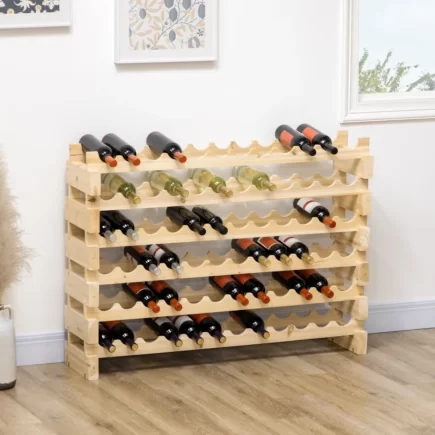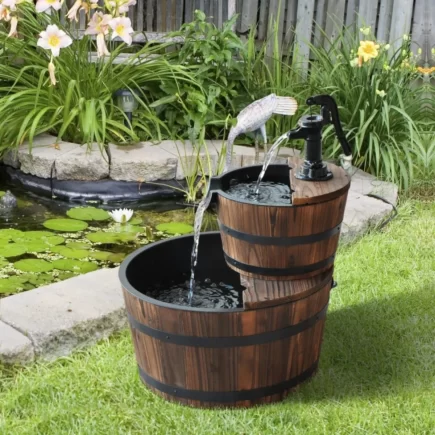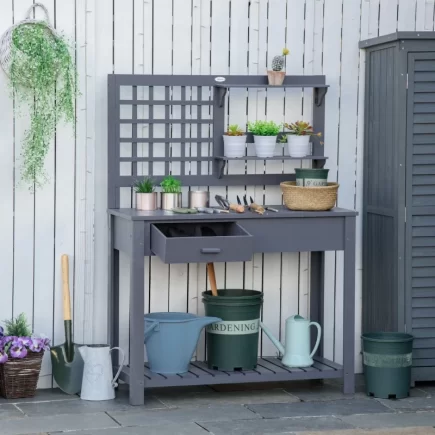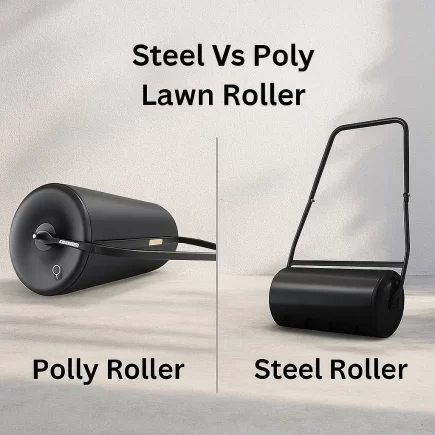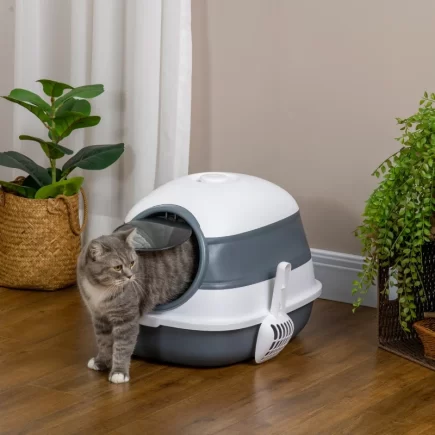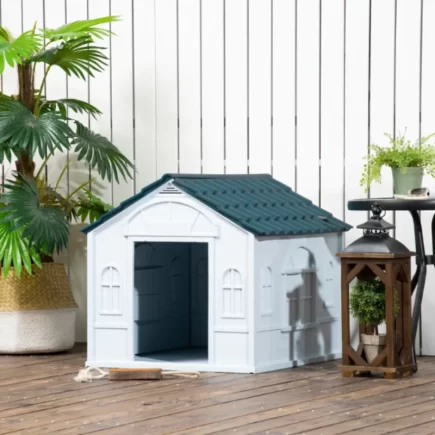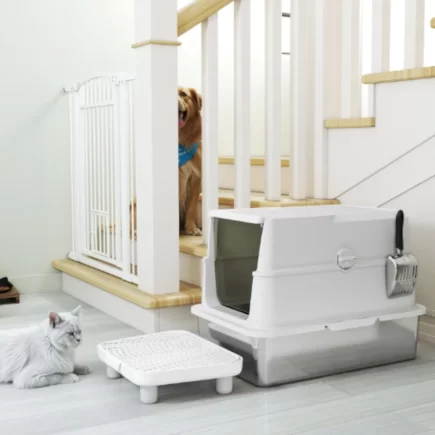
A garden gate is more than a practical barrier; it’s an inviting entrance, a decorative feature, and a protective measure for your outdoor space. Whether you’re installing a gate to keep pets secure, block unwanted visitors, or simply enhance the overall appeal of your yard, learning how to do it right is essential to ensure it’s secure, functional, and visually appealing.
Setup Before the First Screw
If you want your garden gate installation to stand the test of time, the secret isn’t just in the materials or tools; it’s in the preparation. Think of this stage as laying the groundwork for a masterpiece.
Essential Tools
Before you start, gather these tools to make the process efficient and hassle-free:
- Screwdriver
- Measuring tape
- Spirit level
- Post hole digger or auger
- Wrench
- Shovel or spade
Materials Checklist
The right materials ensure your gate stands the test of time, especially a black metal design like the one in question:
- Metal garden gate (chain-link design)
- High-quality hinges and latches
- Screws and bolts (weather-resistant)
- Concrete mix (for post-setting)
- Gravel (for added stability on uneven ground)
- Rust-resistant coating or paint
Pro Tip: Opt for pre-treated materials or apply rust-resistant coatings to ensure the black metal gate withstands weather and use over time.
Preparing the Site

Before you begin installation:
- Clear the Area: Remove debris, rocks, and vegetation from the gate’s planned location for a flat, even surface.
- Mark the Position: Measure and mark where the posts will go, keeping in mind the gate’s frame width. Ensure there’s adequate clearance for smooth opening and closing.
- Test the Ground: For uneven terrain, add gravel or level the ground to create a stable foundation.
Quick Checklist
- Is the gate area clear?
- Measurements double-checked?
- Ground levelled or prepped with gravel?
Planning and Accurate Measurements

Measure Twice, Install Once
Accurate measurements set the stage for a seamless installation.
- Width/Height: Measure the gate’s dimensions and ensure the opening is slightly wider to allow smooth movement. Leave 1–2 inches of ground clearance to prevent interference with the ground.
- Depth for Posts: The post hole depth should be at least 1/3 of the post height. For example, a garden post standing 6 feet above ground will need a 2-foot-deep hole.
- Ensure Alignment: Use a string line and spirit level to line up the posts perfectly across the opening. This prevents alignment issues during installation.
Example for Post Depth
| Post Height (Above Ground) | Minimum Hole Depth |
| 4 feet | 1.5 feet |
| 6 feet | 2 feet |
| 8 feet | 2.5 feet |
Helpful Hint: For chain-link style gates, alignment is critical to maintain tension and prevent sagging.
Step 1: Setting the Gate Posts
Dig Post Holes

- Mark the spots where you want to place your posts. Use a measuring tape and string to ensure the posts are evenly spaced.
- Depending on the size of the holes, you can use a post hole digger or an auger.
- Start by digging down to a depth of 2–3 feet.
- Keep the sides of the hole as straight as possible.
- The hole should be about 4–6 inches wider than the diameter of the post.
Add Gravel

- Use small-sized gravel, such as pea gravel or crushed stone.
- Pour a few inches of gravel into the bottom of each hole (about 2–4 inches).
- Spread it out evenly to ensure the gravel covers the base of the hole.
- Use a tamping tool or a piece of scrap wood to pack the gravel down gently.
Secure Posts with Concrete
- Mix and pour concrete into each hole while holding the post in place. Ensure the posts are plumb (vertically straight) by using a spirit level.
- Smooth the surface of the concrete at a slight slope to direct water away from the base. Allow 24–48 hours for the concrete to cure.
Pro Tip: Use temporary wood braces to stabilize posts while the concrete sets.
Step 2: Attach Gate with Post

Align the Gate
With the posts firmly in place, position the metal gate within the opening. Use spacers or small blocks to maintain a 1–2 inch ground gap.
Install Hinges
Attach the hinges to the gate first, lining them up slightly below the centerline for even weight distribution. Then secure the hinges to the post using weather-resistant screws or bolts.
Test the Swing
Open and close the gate several times to ensure smooth movement. Adjust the hinge screws as needed for proper alignment.
Step 3: Secure the Gate Latch and Lock
- Install the latch at a convenient height.
- For added security, consider a deadbolt or padlock.
- Double-check that the latch aligns perfectly with the post receiver and locks firmly.
Troubleshooting Common Issues

| Issue | Solution |
| Uneven or sloped ground | Add gravel or use adjustable hinges to compensate. |
| Sagging gate frame | Reinforce the gate with cross-braces or tension rods. |
| Misaligned posts | Use a string line to adjust and re-align before concrete fully cures. |
| Gate sticking during swing | Sand down any rough edges and test clearance with spacers or blocks. |
Quick Tip: Regular maintenance, like hinge lubrication, can prevent most alignment or movement issues.
Enhancing Aesthetics and Finishing Touches
- Paint Finishing: Apply a rust-resistant black paint or coating for a sleek and durable finish.
- Add Decorative Elements: Finials or decorative post caps can make the gate more visually appealing.
- Lighting: Consider solar-powered lights on gate posts to illuminate the area at night.
Transform Your Home With Garden Gate Installation
Follow these final steps to complete your garden gate project like a pro:
- Confirm measurements and alignment before setting posts.
- Ensure all hardware is securely tightened and the gate swings smoothly.
- Add protective finishes to keep your gate looking new for years to come.
By following these steps, you’ll not only install a functional black metal garden gate but also add a personal touch to your outdoor area. If you are looking for a quality Garden Gate. Visit Aosom for stylish and durable options that meet any need.
FAQs
1. What are the best materials for garden gates?
The best garden gate materials are wood, metal, and vinyl. Wood offers natural beauty but needs maintenance. Metal gates like aluminum or wrought iron are durable and low-maintenance, while vinyl is weather-resistant and mimics wood’s look with minimal upkeep.
2. Can I install a garden gate on uneven ground?
Yes, you can! If your ground is uneven, add gravel or level the area before installation. This will create a stable foundation and ensure the gate remains secure and functional.
3. What should I do if my garden gate sticks when opening?
If your gate sticks, check for rough edges and sand them down. Adjust the hinges for alignment and lubricate if needed. Lastly, test the clearance with spacers to ensure smooth swinging.





